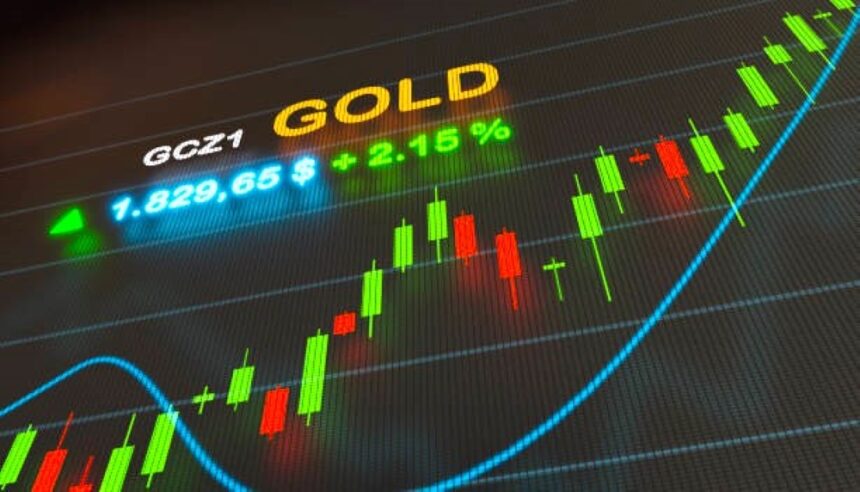Gold Price Climbs Near Record $3,400 as Trump Tariff Shock USD Slump and Safe-Haven Surge Fuel the Rally.
Gold (XAUUSD) prices surged on Monday, continuing their remarkable upward trajectory and hovering just beneath the historic $3,400 threshold. The yellow metal remains firmly supported by heightened demand for safe-haven assets, as markets grapple with rising trade tensions stemming from former US President Donald Trump’s tariff blitz against China and a rapidly weakening US Dollar. Despite technically overbought conditions, the bullish momentum shows little sign of abating, with geopolitical jitters and recession fears stoking demand.
Trade Policy Turmoil Revives Gold’s Safe-Haven Appeal
Trump’s latest salvo in the escalating US-China trade dispute—a series of punitive tariffs that could reach as high as 245% on certain Chinese imports—has unnerved investors worldwide. These duties, alongside China’s retaliatory 125% tariffs on US exports, have significantly soured risk sentiment. Businesses face growing uncertainty about cross-border supply chains, while consumers brace for rising costs on imported goods.
This renewed trade war rhetoric threatens to unravel delicate global economic stability, prompting investors to seek shelter in time-tested safe-haven assets. Historically, gold thrives during geopolitical upheaval, and the current situation is no exception. With tariffs fueling fears of stagflation—a toxic mix of slowing growth and rising prices—gold’s non-yielding but inflation-resistant nature becomes increasingly attractive.
US Recession Fears Deepen as Dollar Crumbles
Adding fuel to the fire is the sharp decline in the US Dollar, which has now slumped to levels not seen since April 2022. The dollar index (DXY) has been under persistent pressure, shedding value as traders digest the potential economic fallout of Trump’s policies. A weakened USD is typically bullish for commodities priced in dollars, including gold, making them cheaper for foreign buyers and boosting demand.
The latest currency rout comes even as Federal Reserve Chair Jerome Powell maintained a relatively hawkish tone. Powell stressed that the Fed remains in a “wait-and-see” mode regarding future interest rate changes. However, markets appear increasingly convinced that monetary easing is back on the table. Traders are now pricing in a full percentage point worth of rate cuts by the end of 2025, with the first possible move coming as early as June.
Lower interest rates reduce the opportunity cost of holding gold, which doesn’t pay interest or dividends. In this context, expectations of looser monetary policy only strengthen the case for holding gold as an alternative store of value.
Technical Picture: Overbought but Undeterred
On the technical front, gold’s relentless rally has pushed the daily Relative Strength Index (RSI) into overbought territory. While this typically signals the potential for a short-term pullback or consolidation, price action so far has remained resilient. The bullish momentum is being reinforced by robust fundamentals, including macroeconomic instability, inflation fears, and weak dollar dynamics.
Traders should, however, remain cautious about initiating fresh long positions without a corrective dip. Short-term retracements toward $3,325 or even the psychological $3,300 level could offer healthier entry points before the next leg higher.
Geopolitical Flashpoints Offer Further Support
Gold’s gains aren’t solely rooted in economic concerns. Recent geopolitical developments continue to reinforce its appeal. Over the weekend, Iran and the US agreed to resume expert-level nuclear talks—a potentially positive signal—but investors remain skeptical about the outcomes. Similarly, Russian President Vladimir Putin declared a one-day ceasefire in Ukraine, sparking a flicker of optimism but little lasting impact on broader market sentiment.
In an increasingly multipolar and unstable world, investors are unwilling to abandon their gold positions based on diplomatic overtures alone. Until concrete de-escalation materializes, safe-haven flows are likely to persist.
Thin Liquidity and Holiday Calm Mask Underlying Market Anxiety
Monday’s surge occurred amid thin trading volumes due to the Easter Monday holiday in several global markets. Reduced liquidity often exaggerates price movements, but the broader picture suggests strong underlying demand rather than speculative noise.
The absence of high-impact US economic data on Monday left markets to focus squarely on geopolitical and macroeconomic themes. That said, the scheduled speech from Chicago Fed President Austan Goolsbee could stir some volatility if he offers clues about the Fed’s rate outlook. Traders are also eyeing Wednesday’s release of flash PMI data from major economies, which could reshape expectations for global growth.
What Lies Ahead: Can Gold Breach $3,400 and Hold?
The immediate question on traders’ minds is whether gold can decisively break above the $3,400 barrier and sustain those gains. Much will depend on upcoming US data, the Fed’s evolving policy signals, and any new developments in the US-China trade saga.
From a broader perspective, gold’s trajectory appears well-supported. Central banks around the world continue to accumulate gold as part of their reserve diversification strategies. Additionally, inflation remains above target in many major economies, while structural risks such as ballooning public debt and de-globalization are gaining attention.
Unless risk appetite stages a dramatic rebound or diplomatic breakthroughs reduce global tensions, gold could see further gains in the coming weeks. Analysts are now eyeing $3,450 and $3,500 as the next potential upside targets.
Why is gold price approaching a record high in 2025?
Is the US Dollar weakness contributing to the gold rally?
How do US tariffs affect gold prices?







